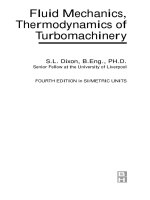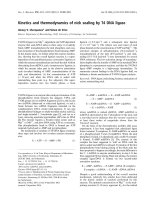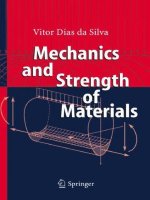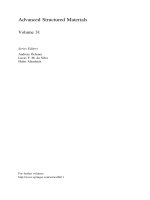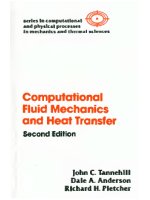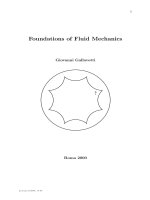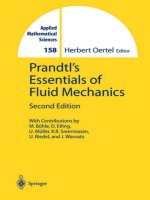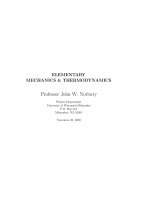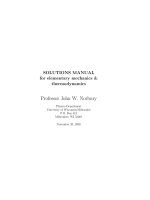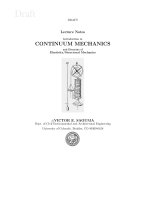Fluid mechanics and thermodynamics of turbomachinery
Bạn đang xem bản rút gọn của tài liệu. Xem và tải ngay bản đầy đủ của tài liệu tại đây (4.4 MB, 422 trang )
Fluid Mechanics,
Thermodynamics of
Turbomachinery
Fifth Edition, in SI/Metric units
S. L. Dixon, B.Eng., Ph.D.
Senior Fellow at the University of Liverpool
AMSTERDAM • BOSTON • HEIDELBERG • LONDON
NEW YORK • OXFORD • PARIS • SAN DIEGO
SAN FRANCISCO • SINGAPORE • SYDNEY • TOKYO
Acquisition Editor: Joel Stein
Project Manager: Carl M. Soares
Editorial Assistant: Shoshanna Grossman
Marketing Manager: Tara Isaacs
Elsevier Butterworth–Heinemann
30 Corporate Drive, Suite 400, Burlington, MA 01803, USA
Linacre House, Jordan Hill, Oxford OX2 8DP, UK
First published by Pergamon Press Ltd. 1966
Second edition 1975
Third editon 1978
Reprinted 1979, 1982 (twice), 1984, 1986 1989, 1992, 1995
Fourth edition 1998
© S.L. Dixon 1978, 1998
No part of this publication may be reproduced, stored in a retrieval system, or transmitted in
any form or by any means, electronic, mechanical, photocopying, recording, or otherwise,
without the prior written permission of the publisher.
Permissions may be sought directly from Elsevier’s Science & Technology Rights Department
in Oxford, UK: phone: (+44) 1865 843830, fax: (+44) 1865 853333, e-mail:
You may also complete your request on-line via the Elsevier
homepage (), by selecting “Customer Support” and then “Obtaining
Permissions.’
Recognizing the importance of preserving what has been written, Elsevier prints its books on
acid-free paper whenever possible.
Library of Congress Cataloging-in-Publication Data
Dixon, S. L. (Sydney Lawrence)
Fluid mechanics and thermodynamics of turbomachinery.
p. cm.
Includes bibliographical references.
1. Turbomachines—Fluid dynamics. I. Title.
TJ267.D5 2005
621.406—dc22
2004022864
British Library Cataloguing-in-Publication Data
A catalogue record for this book is available from the British Library.
ISBN: 0-7506-7870-4
For information on all Elsevier Butterworth–Heinemann publications
visit our Web site at www.books.elsevier.com
05 06 07 08 09 10
10 9 8 7 6 5 4 3 2 1
Printed in the United States of America
Preface to the Fifth Edition
In the earlier editions of this book, open turbomachines, categorised as wind
turbines, propellers and unshrouded fans, were deliberately excluded because of
the conceptual obstacle of precisely defining the mass flow that interacts with the
blades. However, having studied and taught the topic of Wind Turbines for a number
of years at the University of Liverpool, as part of a course on Renewable Energy, it
became apparent this was really only a matter of approach. In this book a new chapter
on wind turbines has been added, which deals with the basic aerodynamics of the wind
turbine rotor. This chapter offers the student a short basic course dealing with the essential fluid mechanics of the machine, together with numerous worked examples at
various levels of difficulty. Important aspects concerning the criteria of blade selection
and blade manufacture, control methods for regulating power output and rotor speed
and performance testing are touched upon. Also included are some very brief notes
concerning public and environmental issues which are becoming increasingly important as they, ultimately, can affect the development of wind turbines. It is a matter
of some regret that many aspects of the nature of the wind, e.g. methodology of determining the average wind speed, frequency distribution, power law and the effect of
elevation (and location), cannot be included, as constraints on book length have to be
considered.
The world is becoming increasingly concerned with the very major issues surrounding the use of various forms of energy. The ever-growing demand for oil and the
undeniably diminishing amount of oil available, global warming seemingly linked to
increased levels of CO2 and the related threat of rising sea levels are just a few of these
issues. Governments, scientific and engineering organisations as well as large (and
small) businesses are now striving to change the profile of energy usage in many countries throughout the world by helping to build or adopt renewable energy sources for
their power or heating needs. Almost everywhere there is evidence of the large-scale
construction of wind turbine farms and plans for even more. Many countries (the UK,
Denmark, Holland, Germany, India, etc.) are aiming to have between 10 and 20% of
their installed power generated from renewable energy sources by around 2010. The
main burden for this shift is expected to come from wind power. It is hoped that this
new chapter will instruct the students faced with the task of understanding the technicalities and science of wind turbines.
Renewable energy topics were added to the fourth edition of this book by way of the
Wells turbine and a new chapter on hydraulic turbines. Some of the derivatives of the
Wells turbine have now been added to the chapters on axial flow and radial flow turbines. It is likely that some of these new developments will flourish and become a major
source of renewable energy once sufficient investment is given to the research.
xi
xii
Preface to the Fifth Edition
The opportunity has been taken to add some new information about the fluid
mechanics of turbomachinery where appropriate as well as including various corrections
to the fourth edition, in particular to the section on backswept vanes of centrifugal
compressors.
S.L.D.
Preface to the Fourth Edition
It is now 20 years since the third edition of this book was published and in that period
many advances have been made to the art and science of turbomachinery design.
Knowledge of the flow processes within turbomachines has increased dramatically
resulting in the appearance of new and innovative designs. Some of the long-standing,
apparently intractable, problems such as surge and rotating stall have begun to yield to
new methods of control. New types of flow machine have made their appearance (e.g.
the Wells turbine and the axi-fuge compressor) and some changes have been made to
established design procedures. Much attention is now being given to blade and flow
passage design using computational fluid dynamics (CFD) and this must eventually
bring forth further design and flow efficiency improvements. However, the fundamentals do not change and this book is still concerned with the basics of the subject as well
as looking at new ideas.
The book was originally perceived as a text for students taking an Honours degree
in engineering which included turbomachines as well as assisting those undertaking
more advanced postgraduate courses in the subject. The book was written for engineers
rather than mathematicians. Much stress is laid on physical concepts rather than mathematics and the use of specialised mathematical techniques is mostly kept to a
minimum. The book should continue to be of use to engineers in industry and technological establishments, especially as brief reviews are included on many important
aspects of turbomachinery giving pointers to more advanced sources of information.
For those looking towards the wider reaches of the subject area some interesting reading
is contained in the bibliography. It might be of interest to know that the third edition
was published in four languages.
A fairly large number of additions and extensions have been included in the book
from the new material mentioned as well as “tidying up” various sections no longer to
my liking. Additions include some details of a new method of fan blade design, the
determination of the design point efficiency of a turbine stage, sections on centrifugal
stresses in turbine blades and blade cooling, control of flow instabilities in axial-flow
compressors, design of the Wells turbine, consideration of rothalpy conservation in
impellers (and rotors), defining and calculating the optimum efficiency of inward flow
turbines and comparison with the nominal design. A number of extensions of existing
topics have been included such as updating and extending the treatment and application of diffuser research, effect of prerotation of the flow in centrifugal compressors
and the use of backward swept vanes on their performance, also changes in the design
philosophy concerning the blading of axial-flow compressors. The original chapter on
radial flow turbines has been split into two chapters; one dealing with radial gas turbines with some new extensions and the other on hydraulic turbines. In a world striving for a “greener” future it was felt that there would now be more than just a little
interest in hydraulic turbines. It is a subject that is usually included in many mechanxiii
xiv
Preface to the Fourth Edition
ical engineering courses. This chapter includes a few new ideas which could be of some
interest.
A large number of illustrative examples have been included in the text and many
new problems have been added at the end of most chapters (answers are given at the
end of the book)! It is planned to publish a new supplementary text called Solutions
Manual, hopefully, shortly after this present text book is due to appear, giving the complete and detailed solutions of the unsolved problems.
S. Lawrence Dixon
Preface to Third Edition
Several modifications have been incorporated into the text in the light of recent
advances in some aspects of the subject. Further information on the interesting phenomenon of cavitation has been included and a new section on the optimum design of
a pump inlet together with a worked example have been added which take into account
recently published data on cavitation limitations. The chapter on three-dimensional
flows in axial turbomachines has been extended; in particular the section concerning
the constant specific mass flow design of a turbine nozzle has been clarified and now
includes the flow equations for a following rotor row. Some minor alterations on the
definition of blade shapes were needed so I have taken the opportunity of including a
simplified version of the parabolic arc camber line as used for some low camber
blading.
Despite careful proof reading a number of errors still managed to elude me in the
second edition. I am most grateful to those readers who have detected errors and communicated with me about them.
In order to assist the reader I have (at last) added a list of symbols used in the text.
S.L.D.
xv
Acknowledgements
The author is indebted to a number of people and manufacturing organisations for
their help and support; in particular the following are thanked:
Professor W. A. Woods, formerly of Queen Mary College, University of London and
a former colleague at the University of Liverpool for his encouragement of the idea of
a fourth edition of this book as well as providing papers and suggestions for some new
items to be included. Professor F. A. Lyman of Syracuse University, New York and
Professor J. Moore of Virginia Polytechnic Institute and State University, Virginia, for
their helpful correspondence and ideas concerning the vexed question of the conservation of rothalpy in turbomachines. Dr Y. R. Mayhew is thanked for supplying me with
generous amounts of material on units and dimensions and the latest state of play on
SI units.
Thanks are also given to the following organisations for providing me with illustrative material for use in the book, product information and, in one case, useful background historical information:
Sulzer Hydro of Zurich, Switzerland; Rolls-Royce of Derby, England; Voith Hydro
Inc., Pennsylvania; and Kvaerner Energy, Norway.
Last, but by no means least, to my wife Rose, whose quiet patience and support
enabled this new edition to be prepared.
xvii
List of Symbols
A
A2
a
a–
a¢
b
Cc
Cf
CL, CD
CP
Cp
Cpi
Cv
CX, CY
c
co
D
Deq
Dh
E, e
F
Fc
f
g
H
HE
Hf
HG
HS
h
I
i
J
j
K, k
KN
L
l
area
area of actuator disc
sonic velocity, position of maximum camber
axial-flow induction factor
tangential flow coefficient
passage width, maximum camber
chordwise force coefficient
tangential force coefficient
lift and drag coefficients
power coefficient
specific heat at constant pressure, pressure coefficient, pressure rise
coefficient
ideal pressure rise coefficient
specific heat at constant volume
axial and tangential force coefficients
absolute velocity
spouting velocity
drag force, diameter
equivalent diffusion ratio
hydraulic mean diameter
energy, specific energy
Prandtl correction factor
centrifugal force in blade
acceleration, friction factor
gravitational acceleration
head, blade height
effective head
head loss fue to friction
gross head
net positive suction head (NPSH)
specific enthalpy
rothalpy
incidence angle
tip–speed ratio
local blade–speed ratio
constants
nozzle velocity coefficient
lift force, length of diffuser wall
blade chord length, pipe length
xix
xx
List of Symbols
M
m
N
NS
NSP
NSS
n
P
p
pa
pv
pw
Q
q
R
Re
RH
Ro
r
S
s
T
t
U
u
V, v
W
DW
w
X
x, y, z
Y
Yid
Yk
Yp
YS
Z
Mach number
mass, molecular “weight”
rotational speed, axial length of diffuser
specific speed (rev)
power specific speed (rev)
suction specific speed (rev)
number of stages, polytropic index
power
pressure
atmospheric pressure
vapour pressure
rate of energy loss
heat transfer, volume flow rate
dryness fraction
reaction, specific gas constant, tip radius of a blade, radius of
slipstream
Reynolds number
reheat factor
universal gas constant
radius
entropy, power ratio
blade pitch, specific entropy
temperature
time, thickness
blade speed, internal energy
specific internal energy
volume, specific volume
work transfer
specific work transfer
relative velocity
axial force
Cartesian coordinate directions
tangential force, actual tangential blade load per unit span
ideal tangential blade load per unit span
tip clearance loss coefficient
profile loss coefficient
net secondary loss coefficient
number of blades, Ainley blade loading parameter
a
b
G
g
d
e
absolute flow angle
relative flow angle, pitch angle of blade
circulation
ratio of specific heats
deviation angle
fluid deflection angle, cooling effectiveness, drag–lift ratio
List of Symbols
z
h
Q
q
l
m
r
s
sb
sc
t
f
Y
W
WS
WSP
WSS
w
–
w
enthalpy loss coefficient, total pressure loss coefficient, relative power
coefficient
efficiency
minimum opening at cascade exit
blade camber angle, wake momentum thickness
profile loss coefficient, blade loading coefficient
dynamic viscosity
kinematic viscosity, blade stagger angle, velocity ratio
density
slip factor, solidity
blade cavitation coefficient
Thoma’s coefficient, centrifugal stress
torque
flow coefficient, velocity ratio, relative flow angle
stage loading factor
speed of rotation (rad/s)
specific speed (rad)
power specific speed (rad)
suction specific speed (rad)
vorticity
stagnation pressure loss coefficient
Subscripts
av
c
D
e
h
i
id
is
m
N
n
o
p
R
r
rel
s
ss
t
xxi
average
compressor, critical
diffuser
exit
hydraulic, hub
inlet, impeller
ideal
isentropic
mean, meridional, mechanical, material
nozzle
normal component
stagnation property, overall
polytropic, constant pressure
reversible process, rotor
radial
relative
isentropic, stall condition
stage isentropic
turbine, tip, transverse
velocity
xxii
List of Symbols
x, y, z
q
cartesian coordinate components
tangential
Superscript
.
¢
*
time rate of change
average
blade angle (as distinct from flow angle)
nominal condition
Contents
PREFACE TO THE FIFTH EDITION
PREFACE TO THE FOURTH EDITION
PREFACE TO THE THIRD EDITION
xi
xiii
xv
ACKNOWLEDGEMENTS xvii
LIST OF SYMBOLS xix
1. Introduction: Dimensional Analysis: Similitude 1
Definition of a turbomachine 1
Units and dimensions 3
Dimensional analysis and performance laws 5
Incompressible fluid analysis 6
Performance characteristics 7
Variable geometry turbomachines 8
Specific speed 10
Cavitation 12
Compressible gas flow relations 15
Compressible fluid analysis 16
The inherent unsteadiness of the flow within turbomachines 20
References 21
Problems 22
2. Basic Thermodynamics, Fluid Mechanics: Definitions of Efficiency
Introduction 24
The equation of continuity 24
The first law of thermodynamics—internal energy 25
The momentum equation—Newton’s second law of motion 26
The second law of thermodynamics—entropy 30
Definitions of efficiency 31
Small stage or polytropic efficiency 35
Nozzle efficiency 42
Diffusers 44
References 54
Problems 55
v
24
vi
Contents
3. Two-dimensional Cascades
56
Introduction 56
Cascade nomenclature 57
Analysis of cascade forces 58
Energy losses 60
Lift and drag 60
Circulation and lift 62
Efficiency of a compressor cascade 63
Performance of two-dimensional cascades 64
The cascade wind tunnel 64
Cascade test results 66
Compressor cascade performance 69
Turbine cascade performance 72
Compressor cascade correlations 72
Fan blade design (McKenzie) 80
Turbine cascade correlation (Ainley and Mathieson) 83
Comparison of the profile loss in a cascade and in a turbine stage 88
Optimum space–chord ratio of turbine blades (Zweifel) 89
References 90
Problems 92
4. Axial-flow Turbines: Two-dimensional Theory
94
Introduction 94
Velocity diagrams of the axial turbine stage 94
Thermodynamics of the axial turbine stage 95
Stage losses and efficiency 97
Soderberg’s correlation 98
Types of axial turbine design 100
Stage reaction 102
Diffusion within blade rows 104
Choice of reaction and effect on efficiency 108
Design point efficiency of a turbine stage 109
Maximum total-to-static efficiency of a reversible turbine stage 113
Stresses in turbine rotor blades 115
Turbine flow characteristics 121
Flow characteristics of a multistage turbine 123
The Wells turbine 125
Pitch-controlled blades 132
References 139
Problems 140
5. Axial-flow Compressors and Fans
145
Introduction 145
Two-dimensional analysis of the compressor stage 146
Contents
Velocity diagrams of the compressor stage 148
Thermodynamics of the compressor stage 149
Stage loss relationships and efficiency 150
Reaction ratio 151
Choice of reaction 151
Stage loading 152
Simplified off-design performance 153
Stage pressure rise 155
Pressure ratio of a multistage compressor 156
Estimation of compressor stage efficiency 157
Stall and surge phenomena in compressors 162
Control of flow instabilities 167
Axial-flow ducted fans 168
Blade element theory 169
Blade element efficiency 171
Lift coefficient of a fan aerofoil 173
References 173
Problems 174
6. Three-dimensional Flows in Axial Turbomachines
177
Introduction 177
Theory of radial equilibrium 177
The indirect problem 179
The direct problem 187
Compressible flow through a fixed blade row 188
Constant specific mass flow 189
Off-design performance of a stage 191
Free-vortex turbine stage 192
Actuator disc approach 194
Blade row interaction effects 198
Computer-aided methods of solving the through-flow problem 199
Application of Computational Fluid Dynamics (CFD) to the design of axial turbomachines 201
Secondary flows 202
References 205
Problems 205
7. Centrifugal Pumps, Fans and Compressors
Introduction 208
Some definitions 209
Theoretical analysis of a centrifugal compressor 211
Inlet casing 212
Impeller 212
Conservation of rothalpy 213
Diffuser 214
208
vii
viii
Contents
Inlet velocity limitations 214
Optimum design of a pump inlet 215
Optimum design of a centrifugal compressor inlet 217
Slip factor 222
Head increase of a centrifugal pump 227
Performance of centrifugal compressors 229
The diffuser system 237
Choking in a compressor stage
240
References 242
Problems 243
8. Radial Flow Gas Turbines
246
Introduction 246
Types of inward-flow radial turbine 247
Thermodynamics of the 90 deg IFR turbine 249
Basic design of the rotor 251
Nominal design point efficiency 252
Mach number relations 256
Loss coefficients in 90 deg IFR turbines 257
Optimum efficiency considerations 258
Criterion for minimum number of blades 263
Design considerations for rotor exit 266
Incidence losses 270
Significance and application of specific speed 273
Optimum design selection of 90 deg IFR turbines 276
Clearance and windage losses 278
Pressure ratio limits of the 90 deg IFR turbine 279
Cooled 90 deg IFR turbines 280
A radial turbine for wave energy conversion 282
References 285
Problems 287
9. Hydraulic Turbines
290
Introduction 290
Hydraulic turbines 291
The Pelton turbine 294
Reaction turbines 303
The Francis turbine 304
The Kaplan turbine 310
Effect of size on turbomachine efficiency 313
Cavitation 315
Application of CFD to the design of hydraulic turbines 319
References 320
Problems 320
Contents
10. Wind Turbines
323
Introduction 323
Types of wind turbine 325
Growth of wind power capacity and cost 329
Outline of the theory 330
Actuator disc approach 330
Estimating the power output 337
Power output range 337
Blade element theory 338
The blade element momentum method 346
Rotor configurations 353
The power output at optimum conditions 360
HAWT blade selection criteria 361
Developments in blade manufacture 363
Control methods (starting, modulating and stopping) 364
Blade tip shapes 369
Performance testing 370
Performance prediction codes 370
Comparison of theory with experimental data 371
Peak and post-peak power predictions 371
Environmental considerations 373
References 374
Bibliography
377
Appendix 1. Conversion of British and US Units to SI Units
Appendix 2. Answers to Problems
Index 383
379
378
ix
CHAPTER 1
Introduction: Dimensional
Analysis: Similitude
If you have known one you have known all. (TERENCE, Phormio.)
Definition of a turbomachine
We classify as turbomachines all those devices in which energy is transferred
either to, or from, a continuously flowing fluid by the dynamic action of one or
more moving blade rows. The word turbo or turbinis is of Latin origin and implies that
which spins or whirls around. Essentially, a rotating blade row, a rotor or an impeller
changes the stagnation enthalpy of the fluid moving through it by either doing positive
or negative work, depending upon the effect required of the machine. These enthalpy
changes are intimately linked with the pressure changes occurring simultaneously in
the fluid.
In the earlier editions of this book, open turbomachines, such as wind turbines, propellers and unshrouded fans were deliberately excluded, primarily because of the conceptual difficulty of properly defining the mass flow that passes through the blades.
However, despite this apparent problem, the study of wind turbines has become an
attractive and even an urgent task, not least because of the almost astonishing increase
in their number. Wind turbines are becoming increasingly significant providers of electrical power and targets have even been set in some countries for at least 10% of power
generation to be effected by this means by 2010. It is a matter of expediency to now
include the aerodynamic theory of wind turbines in this book and so a new chapter has
been added on the topic. It will be observed that the problem of dealing with the indeterminate mass flow has been more or less resolved.
Two main categories of turbomachine are identified: firstly, those that absorb power
to increase the fluid pressure or head (ducted fans, compressors and pumps); secondly,
those that produce power by expanding fluid to a lower pressure or head (hydraulic,
steam and gas turbines). Figure 1.1 shows, in a simple diagrammatic form, a selection
of the many different varieties of turbomachine encountered in practice. The reason
that so many different types of either pump (compressor) or turbine are in use is because
of the almost infinite range of service requirements. Generally speaking, for a given set
of operating requirements one type of pump or turbine is best suited to provide optimum
conditions of operation. This point is discussed more fully in the section of this chapter
concerned with specific speed.
1
2
Fluid Mechanics, Thermodynamics of Turbomachinery
FIG. 1.1. Diagrammatic form of various types of turbomachine.
Turbomachines are further categorised according to the nature of the flow path
through the passages of the rotor. When the path of the through-flow is wholly or mainly
parallel to the axis of rotation, the device is termed an axial flow turbomachine (e.g.
Figure 1.1(a) and (e)). When the path of the through-flow is wholly or mainly in a plane
perpendicular to the rotation axis, the device is termed a radial flow turbomachine (e.g.
Figure 1.1(c)). More detailed sketches of radial flow machines are given in Figures 7.1,
7.2, 8.2 and 8.3. Mixed flow turbomachines are widely used. The term mixed flow in
Introduction: Dimensional Analysis: Similitude
3
this context refers to the direction of the through-flow at rotor outlet when both radial
and axial velocity components are present in significant amounts. Figure 1.1(b) shows
a mixed flow pump and Figure 1.1(d) a mixed flow hydraulic turbine.
One further category should be mentioned. All turbomachines can be classified as
either impulse or reaction machines according to whether pressure changes are absent
or present respectively in the flow through the rotor. In an impulse machine all the pressure change takes place in one or more nozzles, the fluid being directed onto the rotor.
The Pelton wheel, Figure 1.1(f), is an example of an impulse turbine.
The main purpose of this book is to examine, through the laws of fluid mechanics
and thermodynamics, the means by which the energy transfer is achieved in the chief
types of turbomachine, together with the differing behaviour of individual types in operation. Methods of analysing the flow processes differ depending upon the geometrical
configuration of the machine, whether the fluid can be regarded as incompressible or
not, and whether the machine absorbs or produces work. As far as possible, a unified
treatment is adopted so that machines having similar configurations and function are
considered together.
Units and dimensions
The International System of Units, SI (le Système International d’Unités) is a unified
self-consistent system of measurement units based on the MKS (metre–kilogram–
second) system. It is a simple, logical system based upon decimal relationships between
units making it easy to use. The most recent detailed description of SI has been
published in 1986 by HMSO. For an explanation of the relationship between, and use
of, physical quantities, units and numerical values see Quantities, Units and Symbols
(1975), published by The Royal Society or refer to ISO 31/0-1981.
Great Britain was the first of the English-speaking countries to begin, in the 1960s,
the long process of abandoning the old Imperial System of Units in favour of the
International System of Units, and was soon followed by Canada, Australia, New
Zealand and South Africa. In the USA a ten year voluntary plan of conversion to SI
units was commenced in 1971. In 1975 US President Ford signed the Metric Conversion
Act which coordinated the metrication of units, but did so without specifying a schedule of conversion. Industries heavily involved in international trade (cars, aircraft, food
and drink) have, however, been quick to change to SI for obvious economic reasons,
but others have been reluctant to change.
SI has now become established as the only system of units used for teaching
engineering in colleges, schools and universities in most industrialised countries
throughout the world. The Imperial System was derived arbitrarily and has no consistent numerical base, making it confusing and difficult to learn. In this book all numerical problems involving units are performed in metric units as this is more convenient
than attempting to use a mixture of the two systems. However, it is recognised that
some problems exist as a result of the conversion to SI units. One of these is that many
valuable papers and texts written prior to 1969 contain data in the old system of units
and would need converting to SI units. A brief summary of the conversion factors
between the more frequently used Imperial units and SI units is given in Appendix 1
of this book.
4
Fluid Mechanics, Thermodynamics of Turbomachinery
Some SI units
The SI basic units used in fluid mechanics and thermodynamics are the metre (m),
kilogram (kg), second (s) and thermodynamic temperature (K). All the other units
used in this book are derived from these basic units. The unit of force is the newton
(N), defined as that force which, when applied to a mass of 1 kilogram, gives an
acceleration to the mass of 1 m/s2. The recommended unit of pressure is the pascal
(Pa) which is the pressure produced by a force of 1 newton uniformly distributed over
an area of 1 square metre. Several other units of pressure are in widespread use,
however, foremost of these being the bar. Much basic data concerning properties of
substances (steam and gas tables, charts, etc.) have been prepared in SI units with pressure given in bars and it is acknowledged that this alternative unit of pressure will continue to be used for some time as a matter of expediency. It is noted that 1 bar equals
105 Pa (i.e. 105 N/m2), roughly the pressure of the atmosphere at sea level, and is
perhaps an inconveniently large unit for pressure in the field of turbomachinery
anyway! In this book the convenient size of the kilopascal (kPa) is found to be the most
useful multiple of the recommended unit and is extensively used in most calculations
and examples.
In SI the units of all forms of energy are the same as for work. The unit of energy
is the joule (J) which is the work done when a force of 1 newton is displaced through
a distance of 1 metre in the direction of the force, e.g. kinetic energy (1/2 mc2) has
the dimensions kg ¥ m2/s2; however, 1 kg = 1 Ns2/m from the definition of the newton
given above. Hence, the units of kinetic energy must be Nm = J upon substituting
dimensions.
The watt (W) is the unit of power; when 1 watt is applied for 1 second to a system
the input of energy to that system is 1 joule (i.e. 1 J).
The hertz (Hz) is the number of repetitions of a regular occurrence in 1 second.
Instead of writing c/s for cycles/sec, Hz is used.
The unit of thermodynamic temperature is the kelvin (K), written without the ° sign,
and is the fraction 1/273.16 of the thermodynamic temperature of the triple point of
water. The degree celsius (°C) is equal to the unit kelvin. Zero on the celsius scale is
the temperature of the ice point (273.15 K). Specific heat capacity, or simply specific
heat, is expressed as J/kg K or as J/kg°C.
Dynamic viscosity, dimensions ML-1T -1, has the SI units of pascal seconds, i.e.
M
kg
N ◊ s2
∫
=
= Pa ◊ s
LT m ◊ s m ◊ 2 s
Hydraulic engineers find it convenient to express pressure in terms of head of a
liquid. The static pressure at any point in a liquid at rest is, relative to the pressure
acting on the free surface, proportional to the vertical distance of the free surface above
that point. The head H is simply the height of a column of the liquid which can be supported by this pressure. If r is the mass density (kg/m3) and g the local gravitational
acceleration (m/s2), then the static pressure p (relative to atmospheric pressure) is
p = rgH, where H is in metres and p is in pascals (or N/m2). This is left for the student
to verify as a simple exercise.
Introduction: Dimensional Analysis: Similitude
5
Dimensional analysis and performance laws
The widest comprehension of the general behaviour of all turbomachines is, without
doubt, obtained from dimensional analysis. This is the formal procedure whereby the
group of variables representing some physical situation is reduced into a smaller
number of dimensionless groups. When the number of independent variables is not too
great, dimensional analysis enables experimental relations between variables to be
found with the greatest economy of effort. Dimensional analysis applied to turbomachines has two further important uses: (a) prediction of a prototype’s performance from
tests conducted on a scale model (similitude); (b) determination of the most suitable
type of machine, on the basis of maximum efficiency, for a specified range of head,
speed and flow rate. Several methods of constructing non-dimensional groups have
been described by Douglas et al. (1995) and by Shames (1992) among other authors.
The subject of dimensional analysis was made simple and much more interesting by
Edward Taylor (1974) in his comprehensive account of the subject. It is assumed here
that the basic techniques of forming non-dimensional groups have already been
acquired by the student.
Adopting the simple approach of elementary thermodynamics, an imaginary envelope (called a control surface) of fixed shape, position and orientation is drawn around
the turbomachine (Figure 1.2). Across this boundary, fluid flows steadily, entering at
station 1 and leaving at station 2. As well as the flow of fluid there is a flow of work
across the control surface, transmitted by the shaft either to, or from, the machine. For
the present all details of the flow within the machine can be ignored and only externally observed features such as shaft speed, flow rate, torque and change in fluid properties across the machine need be considered. To be specific, let the turbomachine be
a pump (although the analysis could apply to other classes of turbomachine) driven by
an electric motor. The speed of rotation N, can be adjusted by altering the current to
the motor; the volume flow rate Q, can be independently adjusted by means of a throttle valve. For fixed values of the set Q and N, all other variables such as torque t, head
H, are thereby established. The choice of Q and N as control variables is clearly arbitrary and any other pair of independent variables such as t and H could equally well
FIG. 1.2. Turbomachine considered as a control volume.
6
Fluid Mechanics, Thermodynamics of Turbomachinery
have been chosen. The important point to recognise is that there are for this pump, two
control variables.
If the fluid flowing is changed for another of different density r, and viscosity m, the
performance of the machine will be affected. Note, also, that for a turbomachine handling compressible fluids, other fluid properties are important and are discussed later.
So far we have considered only one particular turbomachine, namely a pump of a
given size. To extend the range of this discussion, the effect of the geometric variables
on the performance must now be included. The size of machine is characterised by the
impeller diameter D, and the shape can be expressed by a number of length ratios, l1/D,
l2/D, etc.
Incompressible fluid analysis
The performance of a turbomachine can now be expressed in terms of the control
variables, geometric variables and fluid properties. For the hydraulic pump it is convenient to regard the net energy transfer gH, the efficiency h, and power supplied P,
as dependent variables and to write the three functional relationships as
(1.1a)
(1.1b)
(1.1c)
By the procedure of dimensional analysis using the three primary dimensions, mass,
length and time, or alternatively, using three of the independent variables we can form
the dimensionless groups. The latter, more direct procedure requires that the variables
selected, r, N, D, do not of themselves form a dimensionless group. The selection of
r, N, D as common factors avoids the appearance of special fluid terms (e.g. m, Q) in
more than one group and allows gH, h and P to be made explicit. Hence the three relationships reduce to the following easily verified forms.
Energy transfer coefficient, sometimes called head coefficient
(1.2a)
(1.2b)
Power coefficient
(1.2c)
The non-dimensional group Q/(ND3) is a volumetric flow coefficient and rND2/m is
a form of Reynolds number, Re. In axial flow turbomachines, an alternative to Q/(ND3)
Introduction: Dimensional Analysis: Similitude
7
which is frequently used is the velocity (or flow) coefficient f = cx /U where U is blade
tip speed and cx the average axial velocity. Since
and U ϰ ND.
then
Because of the large number of independent groups of variables on the right-hand side
of eqns. (1.2), those relationships are virtually worthless unless certain terms can be
discarded. In a family of geometrically similar machines l1/D, l2/D are constant and
may be eliminated forthwith. The kinematic viscosity, = m/r is very small in turbomachines handling water and, although speed, expressed by ND, is low the Reynolds
number is correspondingly high. Experiments confirm that effects of Reynolds number
on the performance are small and may be ignored in a first approximation. The functional relationships for geometrically similar hydraulic turbomachines are then,
(1.3a)
(1.3b)
(1.3c)
This is as far as the reasoning of dimensional analysis alone can be taken; the actual
form of the functions f4, f5 and f6 must be ascertained by experiment.
ˆ may be immediately stated. For a pump the net
One relation between y, f, h and P
hydraulic power, PN equals rQgH which is the minimum shaft power required in the
absence of all losses. No real process of power conversion is free of losses and the
actual shaft power P must be larger than PN. We define pump efficiency (more precise
definitions of efficiency are stated in Chapter 2) h = PN/P = rQgH/P. Therefore
(1.4)
ˆ = fy/h. For a turbine the net hydraulic
Thus f6 may be derived from f4 and f5 since P
power PN supplied is greater than the actual shaft power delivered by the machine and
the efficiency h = P/PN. This can be rewritten as Pˆ = hfy by reasoning similar to the
above considerations.
Performance characteristics
The operating condition of a turbomachine will be dynamically similar at two different rotational speeds if all fluid velocities at corresponding points within the machine
are in the same direction and proportional to the blade speed. If two points, one on each
of two different head–flow characteristics, represent dynamically similar operation of
the machine, then the non-dimensional groups of the variables involved, ignoring
Reynolds number effects, may be expected to have the same numerical value for both
